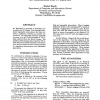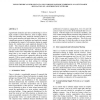113 search results - page 6 / 23 » Determining the Significance of Item Order In Randomized Pro... |
COGSCI
2002
13 years 7 months ago
2002
We address the problem of predicting how people will spontaneously divide into groups a set of novel items. This is a process akin to perceptual organization. We therefore employ ...
AAAI
1996
13 years 9 months ago
1996
This paper describes the results of applying a modified version of hierarchical task-network (HTN) planning to the problem of declarer play in contract bridge. We represent inform...
KDD
2004
ACM
14 years 8 months ago
2004
ACM
In recent years, various constrained frequent pattern mining problem formulations and associated algorithms have been developed that enable the user to specify various itemsetbase...
ACL
1992
13 years 9 months ago
1992
An algorithm is proposed to determine antecedents for VP ellipsis. The algorithm eliminates impossible antecedents, and then imposes a preference ordering on possible antecedents....
WSC
2007
13 years 10 months ago
2007
Agent-based simulation provides a methodology to investigate complex systems behavior, such as supply chains, while incorporating many empirical elements relative to both systems ...


